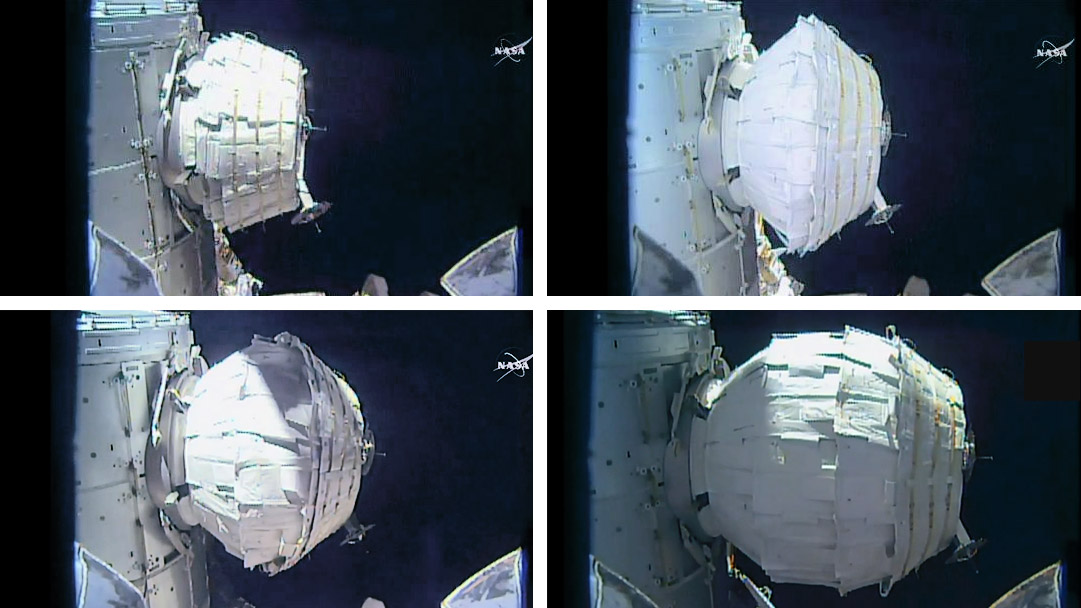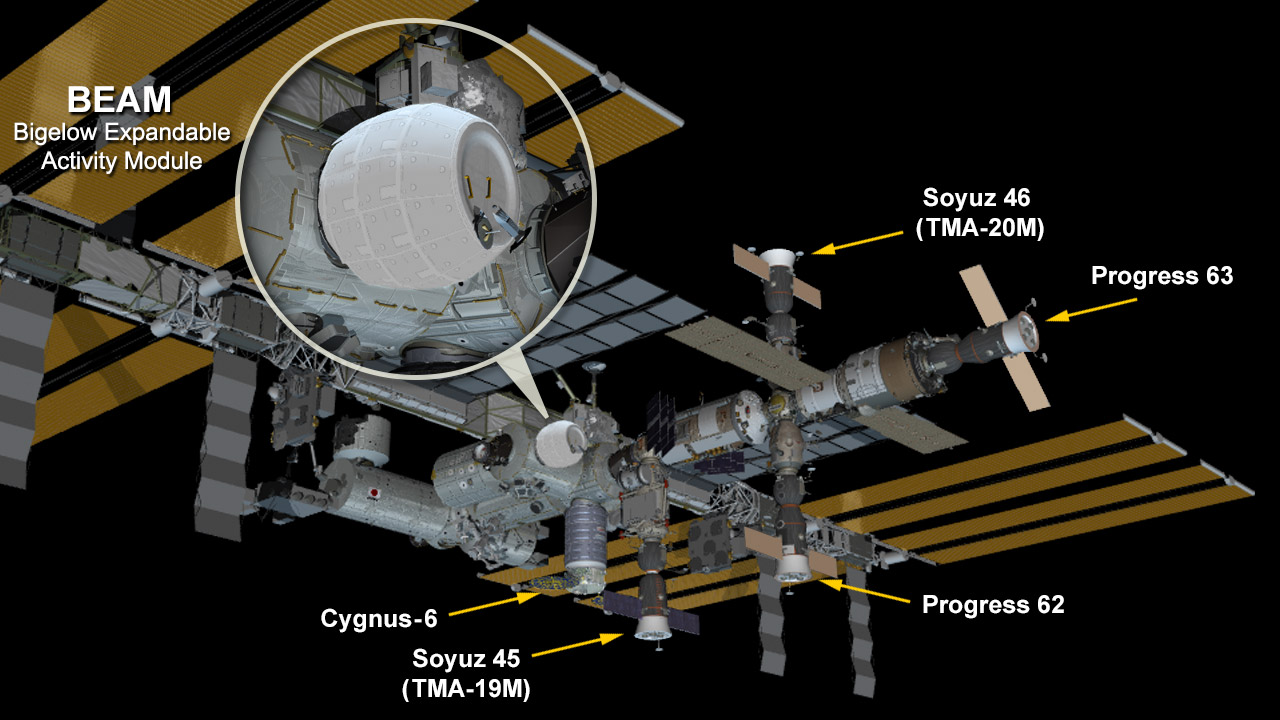1st Inflatable Habitat for Astronauts All Pumped Up on Space Station

Houston, you have an epic balloon room in space. NASA has inflated the first-ever expandable room for astronauts on the International Space Station, a round module that made occasional popcorn-like popping sounds as it reached its full size.
It took NASA astronaut Jeff Williams on the station more than seven hours to inflate the privately built Bigelow Expandable Activity Module today (May 28). The new space room, called BEAM for short, was built for NASA by Bigelow Aerospace. Its inflation went at a glacial pace — a safety precaution since BEAM is the first of its kind — with Williams reporting that he heard popping noises with almost every short burst of air he fed into the module through a manual valve.
"It sounds sort of like popcorn in a frying pan starts up," Williams said. Flight controllers at NASA's Mission Control center in Houston said the sound was expected and a welcome one, since it indicated BEAM was expanding as planned. [The Inflatable BEAM Space Room in Pictures]
The inflation process began in earnest Saturday at 9:04 a.m. EDT (1304 GMT) and was complete by 4:34 p.m. EDT (2034 GMT). Ten minutes later, the ball-shaped room was pressurized to match the pressure of the rest of the International Space Station.
NASA and Bigelow Aerospace initially tried to inflate the BEAM module on Thursday (May 26), but the expansion process did not go as expected. During that first two-hour attempt, NASA engineers detected higher-than-expected pressures inside the BEAM habitat, but later determined it was likely due to the module's fabric layers sticking together.

The fully inflated BEAM module is 13 feet (4 meters) long and 10.5 feet (3.2 m) wide, and contains 565 cubic feet (16 cubic m) of living space. But at launch, it was compressed into a space 7 feet long by 8 feet wide (2.1 by 2.4 m).
"Congratulations to the entire BEAM team," Bigelow Aerospace representatives wrote on Twitter after the inflation. "A significant milestone has been accomplished."
Breaking space news, the latest updates on rocket launches, skywatching events and more!
BEAM is a prototype space habitat that can be folded up like a parachute and reduced to nearly one-fifth its inflated size, making it easier to pack for a trip into space. Expandable habitats take up less room in a payload fairing than rigid, metal habitats, and are also lighter, which lowers the cost of sending them to space. In 2013, NASA awarded a $17.8 million contract to Bigelow Aerospace to build BEAM for testing at the space station.
"This first test of an expandable module will allow investigators to gauge how well the habitat performs and, specifically, how well it protects against solar radiation, space debris and the temperature extremes of space," NASA officials said in a statement.

With the BEAM inflation complete, NASA and Bigelow Aerospace will begin a weeklong series of leak checks. Only once those leak checks are complete will astronauts be allowed inside BEAM module for the first time, NASA officials have said.
The station crewmembers were initially scheduled to enter the BEAM habitat for the first time on Thursday (June 2), but those plans changed after Thursday's aborted inflation attempt. The leak checks should take about a week to complete, NASA added.
The Las Vegas-based Bigelow Aerospace, has tested its expandable habitats in space, but never with human occupants. The space station crewmembers will enter the habitat several times a year to "retrieve sensor data and assess conditions inside the module," according to NASA officials, but the crewmembers will not occupy the habitat full time.
Bigelow has said that it would like to put expandable habitats on the moon someday. The company has also said it will send one of its massive B330 modules into orbit in 2020, in cooperation with the private spaceflight provider United Launch Alliance.
BEAM flew to the station in a SpaceX Dragon cargo capsule and arrived on April 10. It will remain on the station for two years, after which it will be jettisoned from the station using the Canadarm2, the robotic arm that can be operated from inside the station. Then, the habitat will fall toward Earth and burn up in the atmosphere.
Follow Calla Cofield @callacofield.Follow us @Spacedotcom, Facebook and Google+. Original article on Space.com.
Join our Space Forums to keep talking space on the latest missions, night sky and more! And if you have a news tip, correction or comment, let us know at: community@space.com.

Calla Cofield joined Space.com's crew in October 2014. She enjoys writing about black holes, exploding stars, ripples in space-time, science in comic books, and all the mysteries of the cosmos. Prior to joining Space.com Calla worked as a freelance writer, with her work appearing in APS News, Symmetry magazine, Scientific American, Nature News, Physics World, and others. From 2010 to 2014 she was a producer for The Physics Central Podcast. Previously, Calla worked at the American Museum of Natural History in New York City (hands down the best office building ever) and SLAC National Accelerator Laboratory in California. Calla studied physics at the University of Massachusetts, Amherst and is originally from Sandy, Utah. In 2018, Calla left Space.com to join NASA's Jet Propulsion Laboratory media team where she oversees astronomy, physics, exoplanets and the Cold Atom Lab mission. She has been underground at three of the largest particle accelerators in the world and would really like to know what the heck dark matter is. Contact Calla via: E-Mail – Twitter
